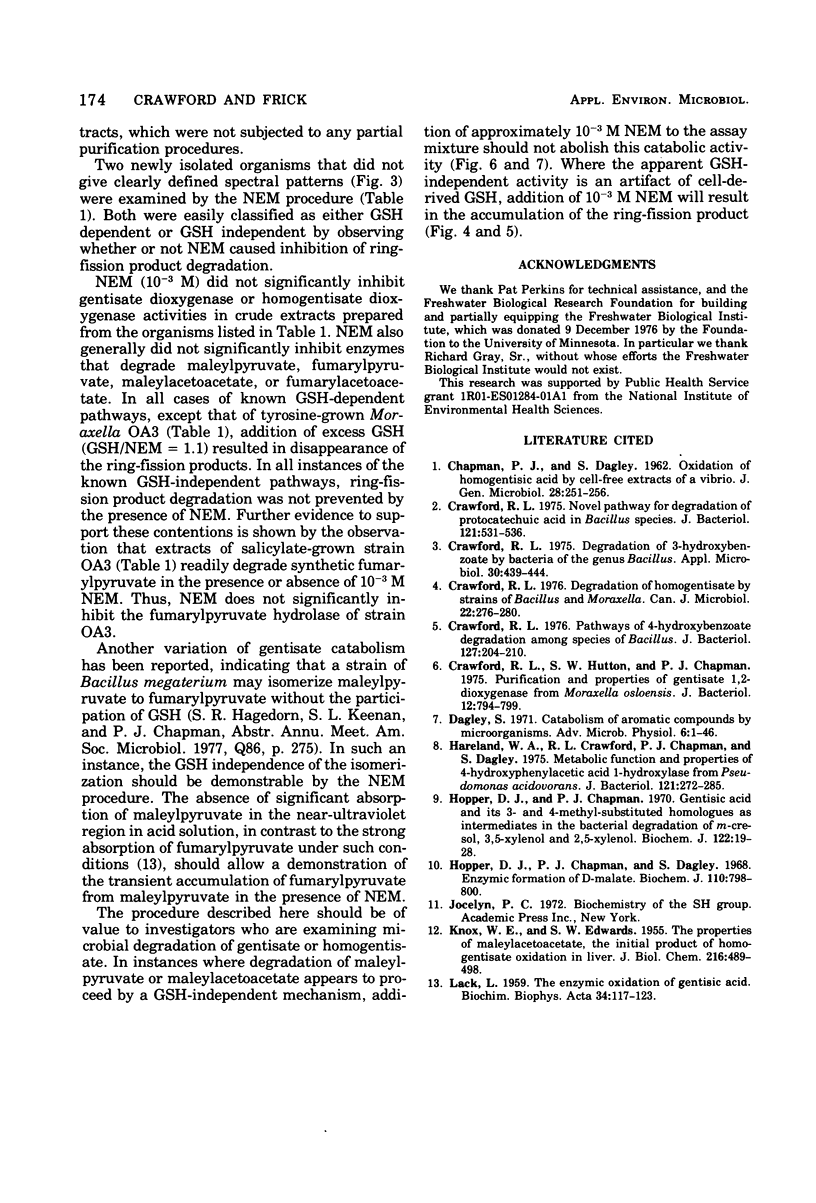Abstract
A total of four pathways are known for the catabolism by microorganisms of gentisate (2,5-dihydroxybenzoate) and homogentisate (2,5-dihydroxyphenylacetate). Both of these dihydric phenols can be degraded by either a glutathione-dependent or a glutathione-independent reaction sequence. We found that it is not always possible to unequivocally assign glutathione dependence or independence to a particular catabolic sequence by using the well-established spectrophotometric assays at 330 nm (gentisate pathway) or 320 nm (homogentisate pathway). This paper reports a modification of the classical spectrophotometric assays that allowed an unequivocal differentiation between glutathion-dependent and glutathione-independent pathways, even when crude cell extracts contained significant quantities of cell-derived, reduced glutathione. This was accomplished by performing assays in the presence of an approximately 10(-3) M solution of the sulfhydryl-binding agent N-ethylmaleimide.
Full text
PDF




Selected References
These references are in PubMed. This may not be the complete list of references from this article.
- CHAPMAN P. J., DAGLEY S. Oxidation of homogentistic acid by cell-free extracts of a vibrio. J Gen Microbiol. 1962 Jun;28:251–256. doi: 10.1099/00221287-28-2-251. [DOI] [PubMed] [Google Scholar]
- Crawford R. L. Degradation of 3-hydroxybenzoate by bacteria of the genus Bacillus. Appl Microbiol. 1975 Sep;30(3):439–444. doi: 10.1128/am.30.3.439-444.1975. [DOI] [PMC free article] [PubMed] [Google Scholar]
- Crawford R. L. Degradation of homogentisate by strains of Bacillus and Moraxella. Can J Microbiol. 1976 Feb;22(2):276–280. doi: 10.1139/m76-037. [DOI] [PubMed] [Google Scholar]
- Crawford R. L., Hutton S. W., Chapman P. J. Purification and properties of gentisate 1,2-dioxygenase from Moraxella osloensis. J Bacteriol. 1975 Mar;121(3):794–799. doi: 10.1128/jb.121.3.794-799.1975. [DOI] [PMC free article] [PubMed] [Google Scholar]
- Crawford R. L. Novel pathway for degradation of protocatechuic acid in Bacillus species. J Bacteriol. 1975 Feb;121(2):531–536. doi: 10.1128/jb.121.2.531-536.1975. [DOI] [PMC free article] [PubMed] [Google Scholar]
- Crawford R. L. Pathways of 4-hydroxybenzoate degradation among species of Bacillus. J Bacteriol. 1976 Jul;127(1):204–210. doi: 10.1128/jb.127.1.204-210.1976. [DOI] [PMC free article] [PubMed] [Google Scholar]
- Dagley S. Catabolism of aromatic compounds by micro-organisms. Adv Microb Physiol. 1971;6(0):1–46. doi: 10.1016/s0065-2911(08)60066-1. [DOI] [PubMed] [Google Scholar]
- Hareland W. A., Crawford R. L., Chapman P. J., Dagley S. Metabolic function and properties of 4-hydroxyphenylacetic acid 1-hydroxylase from Pseudomonas acidovorans. J Bacteriol. 1975 Jan;121(1):272–285. doi: 10.1128/jb.121.1.272-285.1975. [DOI] [PMC free article] [PubMed] [Google Scholar]
- Hopper D. J., Chapman P. J., Dagley S. Enzymic formation of D-malate. Biochem J. 1968 Dec;110(4):798–800. doi: 10.1042/bj1100798. [DOI] [PMC free article] [PubMed] [Google Scholar]
- Hopper D. J., Chapman P. J. Gentisic acid and its 3- and 4-methyl-substituted homologoues as intermediates in the bacterial degradation of m-cresol, 3,5-xylenol and 2,5-xylenol. Biochem J. 1971 Mar;122(1):19–28. doi: 10.1042/bj1220019. [DOI] [PMC free article] [PubMed] [Google Scholar]
- KNOX W. E., EDWARDS S. W. The properties of maleylacetoacetate, the initial product of homogentisate oxidation in liver. J Biol Chem. 1955 Oct;216(2):489–498. [PubMed] [Google Scholar]
- LACK L. The enzymic oxidation of gentisic acid. Biochim Biophys Acta. 1959 Jul;34:117–123. doi: 10.1016/0006-3002(59)90239-2. [DOI] [PubMed] [Google Scholar]


